Valuation Methods for Early-Stage Startups – The Simple Way

Valuing an early-stage startup can feel like trying to measure fog. There’s little revenue, no profits, and uncertainty everywhere. Yet, investors and founders still need a baseline valuation to move forward.
Here are a few simple methods often used at the early stage:
1. Comparable (Market Multiple) Method
Look at similar startups in the same industry, stage, and geography. If they’re valued at, say, 5x revenue (or projected revenue), you apply that multiple to your business.
Example: If a comparable startup with $200K in revenue is valued at $1M, your startup with $100K may be valued at ~$500K.
2. Scorecard Method
Investors compare your startup against others they’ve funded in the same sector. They adjust the average valuation up or down based on factors like team quality, market potential, and product uniqueness.
It’s more about judgment than hard numbers.
3. Berkus Method
Assigns fixed dollar values to different aspects: idea, prototype, team, strategic relationships, and sales traction. Adds them up to reach a reasonable early-stage valuation.
Great for idea-stage startups with little financial history.
4. Rule of Thumb (Founder-Investor Agreement)
Sometimes, it’s just a negotiated number that balances founder expectations and investor risk appetite. Simple, but very common in practice.
Final Thought:
At the early stage, valuation is more art than science. It’s not about precise numbers but about aligning vision, potential, and risk between founders and investors. Remember — the goal isn’t just to get a valuation; it’s to get the right partners onboard

